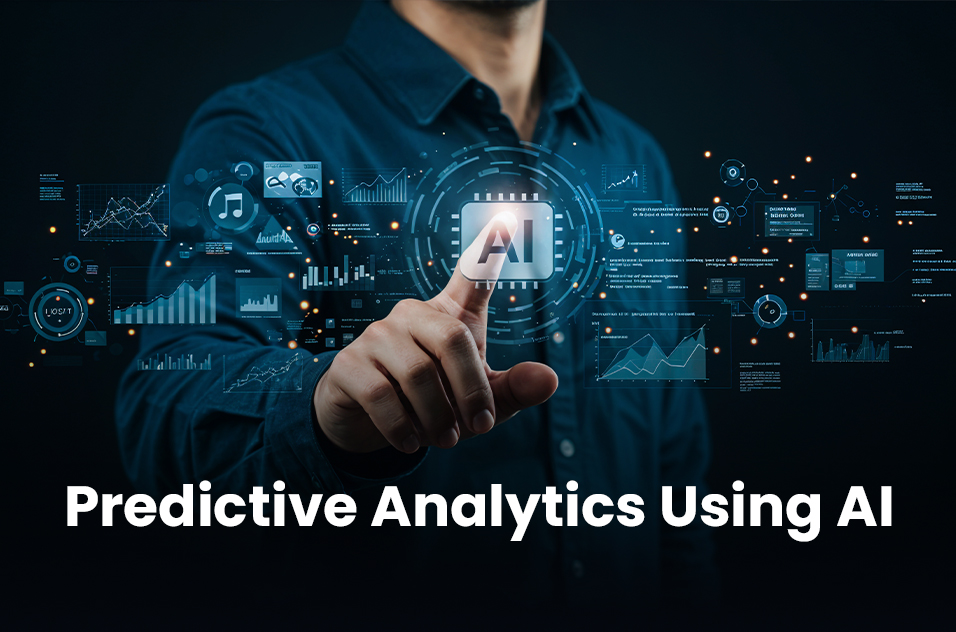
In today’s data-driven global economy, businesses are constantly seeking innovative ways to leverage information for a competitive edge. Predictive Analytics Using AI has emerged as a powerful solution, enabling organizations to forecast trends, improve decision-making, and drive sustainable success.
From the UAE to the broader Middle East and across the US, companies are rapidly integrating AI-powered strategies into their operations. Understanding the specifics of Predictive Analytics Using AI is now essential for staying ahead in competitive and fast-changing markets.
Predictive analytics using AI means using smart computer programs and past data to make informed predictions about what will happen in the future. It works by combining statistical methods, machine learning, and historical information to spot patterns and predict outcomes.
Unlike traditional analysis, which only looks at what has already happened, predictive AI looks ahead, helping businesses plan better, understand customer needs, avoid risks, and use resources more effectively.
1. Data Integration
AI-driven predictive analytics allows for seamless data integration from various sources, providing a comprehensive view of business performance and trends.
2. Insights Generation
By analyzing Past data, businesses can discover hidden patterns and generate valuable insights into customer behavior, operational efficiency, and Market changes.
3. Real-Time Analysis
With AI, companies can handle and study data in real time, allowing quick decisions in response to new trends or problems.
4. Enhanced Accuracy
Predictive analytics using AI often results in more accurate forecasts compared to traditional methods, thanks to its ability to learn from large data sets and improve over time.
Businesses across various sectors are harnessing the power of AI to improve their predictive analytics capabilities. A few examples of AI predictive analytics:
Boost the impact of predictive analytics by following these essential tips
1. Define Clear Objectives:
Before deploying predictive analytics, establish clear business objectives to guide the selection of relevant metrics.
2. Ensure Data Quality:
Accurate predictions start with reliable data. Maintain clean, well-structured datasets by using robust data cleansing practices and effective data management systems.
3. Choose the Right Tools:
Leverage the various predictive analytics AI tools available. Look for platforms that fit your business needs and offer robust analytical capabilities.
4. Involve Stakeholders:
Engage key team members from different departments to ensure diverse perspectives and a holistic approach to analytics.
5. Continuously Monitor and Refine:
Predictive models are not static; they should be regularly reviewed and refined to maintain accuracy and relevance as market conditions change.
As companies in Spain and the Middle East pivot towards digital transformation, the application of AI predictive analysis is becoming a strategic necessity.
Here’s how businesses in these regions can utilize predictive analytics:
Predictive analytics using AI empowers businesses to forecast outcomes by blending historical data, algorithms, and machine learning. Partnering with AI analytics companies provides access to tailored solutions, from advanced tools to custom models that align with business goals.
By leveraging AI predictive analytics, AI predictive analytics organizations can enhance marketing, optimize supply chains, assess risks accurately, and gain a decisive competitive edge in today’s fast-paced market.
Predictive analytics using AI is rapidly evolving, with advancements such as:
In today’s competitive market, predictive analytics using AI is a powerful approach for businesses to stay ahead. Converting historical data into actionable forecasts enables leaders to anticipate market changes, reduce risks, and improve efficiency. The use of machine learning to predict future outcomes, seen in predictive AI examples like fraud detection, demand forecasting, and personalized marketing.
With the rise in predictive analytics jobs, companies are seeking practical, industry-focused solutions. Technology providers like Zoondia ,We work closely with businesses implement AI-driven strategies that address specific challenges and open doors to new opportunities without adding operational complexity.
Predictive analytics using AI is revolutionizing business operations in fast-paced markets like Spain, the Middle East, the US, and beyond. By leveraging AI-driven insights, companies can forecast trends, minimize risks, and seize opportunities ahead of time.
Now is the moment for business owners and professionals to explore predictive analytics AI tools or collaborate with trusted AI analytics companies, ensuring they stay competitive in an increasingly data-driven world.
FAQs
1 . What are examples of predictive AI?
Predictive AI examples include sales forecasting, fraud detection, churn prediction, demand forecasting, and predictive maintenance.
2. What are some predictive AI examples relevant to my industry?
Examples include customer churn prediction, sales forecasting, fraud detection, demand planning, and personalized marketing recommendations applicable across retail, finance, healthcare, and manufacturing.
3. What services does Zoondia offer in Predictive Analytics Using AI?
Zoondia delivers complete Predictive Analytics Using AI solutions, from data preparation and machine learning to custom models and real-time insights, empowering smarter business decisions.
4 . What is predictive AI, and how is it different from traditional analytics?
Predictive AI uses machine learning and algorithms to forecast future trends, while traditional analytics focuses on analyzing past events without forecasting capabilities.
5. Is AI predictive analysis secure and reliable for sensitive business data?
Yes, when implemented with strong encryption, compliance standards, and secure data handling practices, AI predictive analysis can be both safe and reliable.
By continuing to use the website, you agree to our Cookie Policy. To learn more about how we process your personal data, read our Privacy Policy
